In this guide, we cover everything you need to know about killifish – including common killifish types, care/tank requirements, and a complete breeding guide.
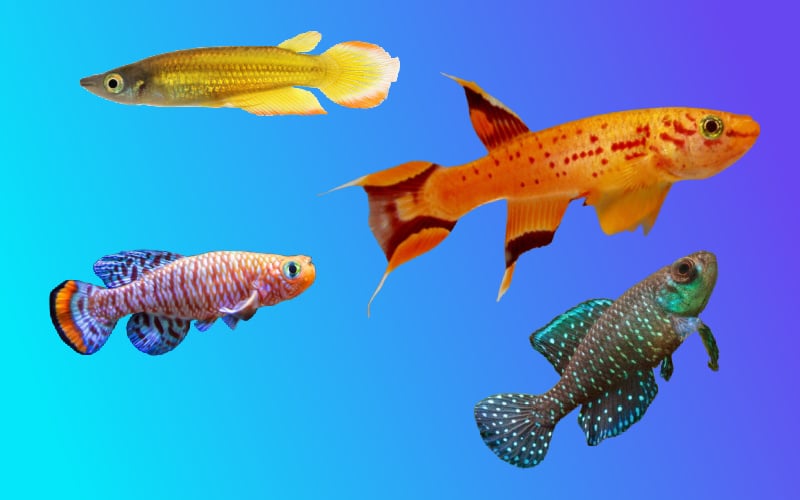
Even aquarists who have been in the hobby for decades might not know very much about Killifish. This is ironic, considering they are some of the most beautiful and widespread fish on the planet.
Killifish are easily some of the weirdest fish as well – some species are male and female at the same time. Some can survive months out of the water, while others even reproduce in ponds and streams that dry up for part of the year.
Killifish are well worth your attention but you’ll need to do a bit of research and hunt around to find them. Specialty aquarium stores may carry them, but putting an order in is the safest bet.
What Are Killifish?
Killifish are egg-laying Cyprinodontiformes, a sizable order that includes familiar fish like Livebearers (Guppies and Platies).
If you compare Killifish with Livebearers you’ll see several similarities such as a dorsal fin placed closer to the tail, a flattened back and head, and an upturned mouth.
All of these are adaptations for dwelling at the surface to pick off the falling insects, aquatic bugs, and mosquito larvae these fish love to consume.
Killifish are easy to obtain but more of a niche fish because of their complex reproduction strategies and picky eating habits. They are informally grouped into three varieties: annual, semi-annual, and non-annual.
- Annual Killifish are found in seasonal ponds and lakes that eventually dry up each year. They have the shortest lifespan of all Killifish; 9 months to 1 year, however they can live a few months longer in an aquarium. A few species only live for 3 months. The flip side of this is how incredibly fast annual Killifish mature. Some species are sexually mature within 3 weeks of hatching. Annual Killifish eggs require a long “dry” period before hatching. The vividly colored Nothobranchiussp. are all annual Killifish.
- Semi-Annual or Switch Killifish come from seasonal rivers and streams that run dry occasionally but not yearly. Their eggs can be kept under a dry spell but don’t require it. Many Fundulopanchax are semi-annual Killifish.
- Non-Annual Killifish live in permanent bodies of water that don’t dry out. They are the species most likely to be found in aquarium stores because they have longer life spans and breed like other fish. They also grow more slowly since they aren’t racing against droughts. The Desert Pupfish (Cyprinodon macularius) is a non-annual Killifish.
Killifish are found in tropical and subtropical waters on every continent save Australia and Antarctica.
Many live in some of the most extreme habitats imaginable; the Julimes Pupfish (Cyprinodon julimes) lives in a single Mexican hot spring that sits at a constant 46C (114 F).
These and many other species are often endemic, found nowhere else in the world, and are living examples of the artistry of evolution.
Common Types of Killifish Species
Killifish are like the orchids of the aquarium world. There are hundreds of species I could cover here and dozens easily found by aquarists. But the majority are of interest only to specialists.
I’m choosing to cover a diverse selection of species most aquarists will be interested in and can easily be found in stores or online.
Bluefin Notho
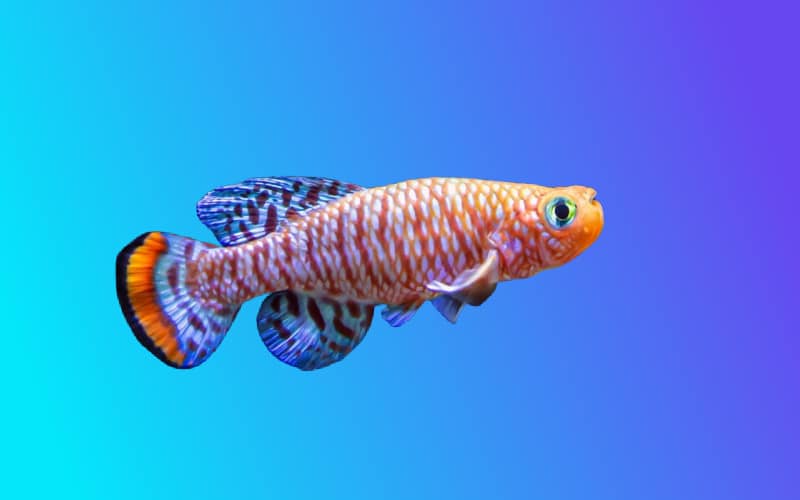
The Bluefin Notho is probably the most popular annual Killifish in the trade. Originally from Mozambique, Bluefin Nothos males are as intensely colored as any reef aquarium fish. Like most Killifish, the females are a drab grey in color. Bluefin Nothos come in a few color morphs as well, including Albino and regional varieties like KNP Black. Nothos usually arrive by mail as dormant eggs to be hatched and raised, making them challenging for beginners.
Bluefin Nothos are carnivorous and have fast metabolisms due to their swift growth rate and prolific breeding patterns. Small, frequent feedings of live and frozen foods lie daphnia, brine shrimp, and tubifex are essential. Nothos can starve before recognizing flakes or pellets as food.
Like most Killifish, Bluefin Nothos are peaceful towards other fish but the males are ceaselessly aggressive towards each other. You either want a single male with several females or several males and females in a spacious tank (20+ gallons) with decorations to break lines of sight and room for them to set up territories and flee on occasion.
There are many more Nothobranchius species that have identical care requirements to the Bluefin Notho. They are found across Eastern Africa, from Sudan to South Africa. These relatives are often more red, gold, or green compared to the Bluefin. Be aware that Nothobranchius species are all closely related and will interbreed if given a chance, which hurts their resale value.
- Scientific Name: Nothobranchius rachovii
- Breeding Habit: Annual
- Adult Size: Up to 2.5″
- Aquarium Size: 5-10 gallons
- Temperament: Peaceful
- Difficulty: Difficult
Neon Striped Lampeye Killifish
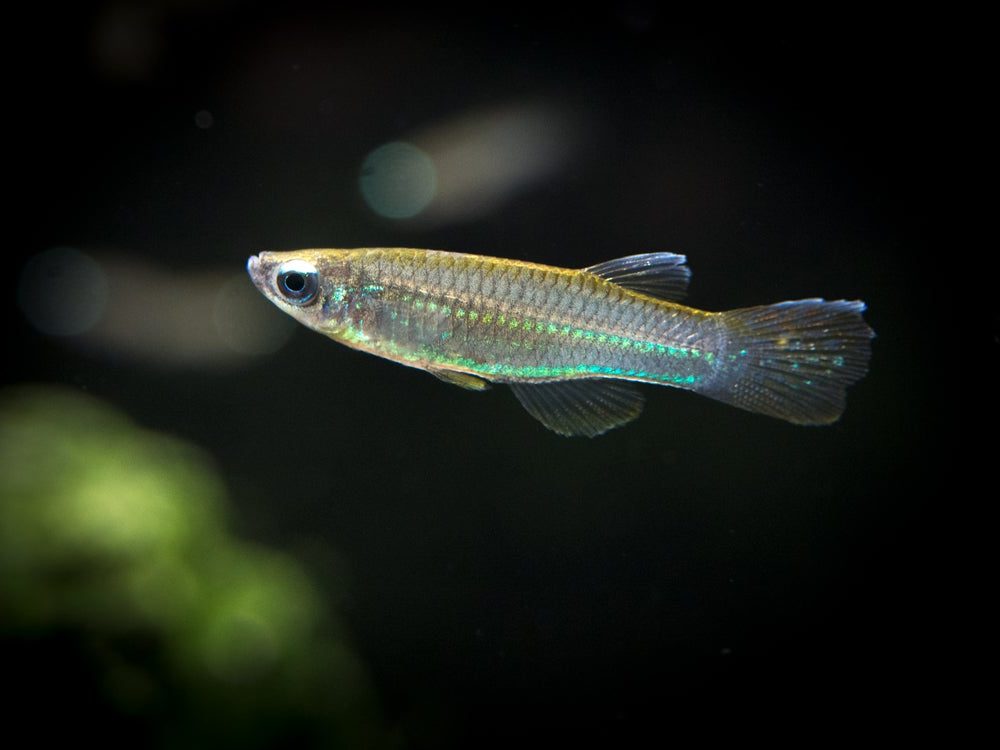
Their name is a mouthful but describes these tiny Killifish perfectly. All Lampeye Killifish have a reflective layer on the upper eye that glows intensely silver under aquarium lighting.
Neon Stripe Lampeyes are native to West Africa and as a non-annual species, live up to 3 years in captivity. Like most Killifish they need frequent feedings of live and frozen foods.
Given their small bodies and mouths, you’ll need to source items like baby brine shrimp, mosquito larvae, and daphnia.
Neon Striped Lampeyes are peaceful to the point of being shy and should be kept in groups of 6 or more in heavily planted aquariums to reduce stress.
They are perfect for nano aquascapes as their pearlescent blue contrasts beautifully with verdant plants, Red Cherry Shrimp, and the dark substrate planted tanks usually use.
- Scientific Name: Aplocheilichthys macrophthalmus
- Breeding Habit: Non-Annual
- Adult Size: 1-1½”
- Aquarium Size: 5+ Gallons
- Temperament: Peaceful; schooling
- Difficulty: Easy
Striped Panchax
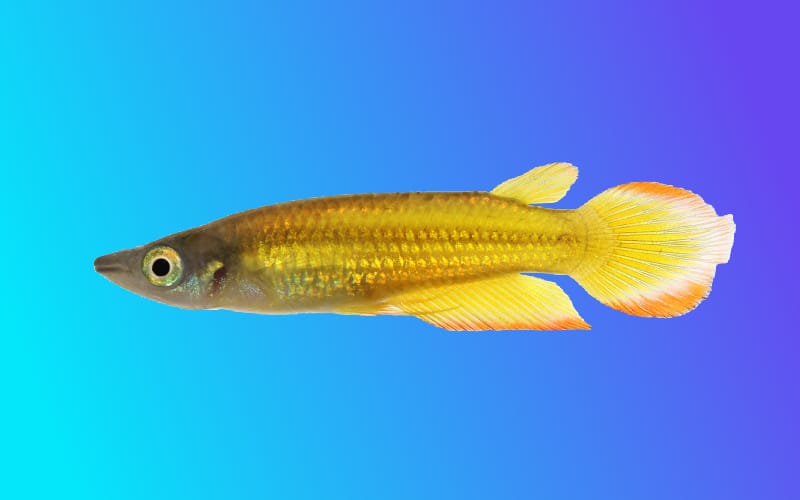
This fairly large Killifish is native to India and Sri Lanka, inhabiting warm streams, rivers, swamps, and even brackish waters.
Reaching up to 4″ in length and with a sizable mouth, Striped Panchax are opportunists that wait at the water’s surface for falling insects, surface dwelling invertebrates, and even unlucky small fish.
Striped Panchax will leap short distances to knock crawling insects off of overhanging branches and are highly sensitive to movement.
The high yellow color morph, known as the Golden Wonder Killifish, is the most common Killifish found in pet stores. Varieties with more red are also available. Striped Panchax are usually aquarium-bred and will accept flakes and pellets.
- Scientific Name: Aplocheilus lineatus
- Breeding Habit: Non-Annual
- Adult Size: Up to 4″
- Aquarium Size: 20+ Gallons
- Temperament: Peaceful but Predatory
- Difficulty: Easy
Blackfin Pearlfish
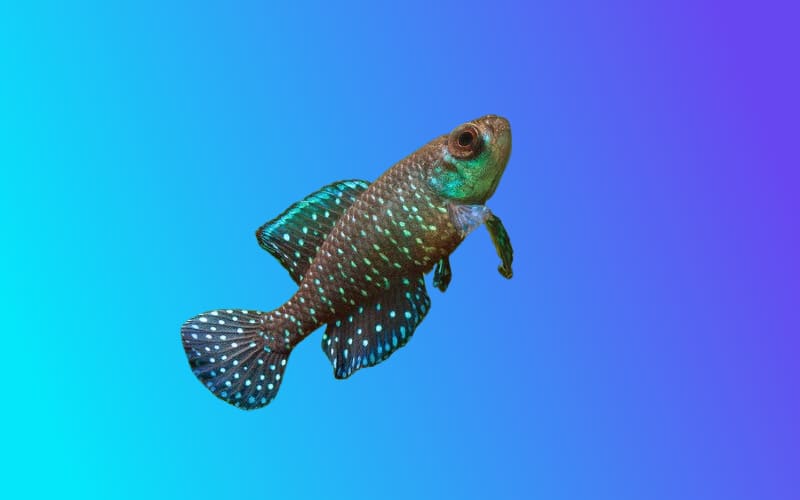
The Blackfin Pearlfish is an annual Killifish from Uruguay, Paraguay, and Argentina. Males are strikingly patterned with sky blue dots on a background of midnight black.
They are unusual in being a temperate species rather than a tropical one. Blackfin Pearlfish prefer temperatures from 60-68F and their eggs should be kept similarly cool during their dry season.
Despite being annual Killifish, some of the other Austrolebias species grow fairly large, reaching as long as 6 inches. Like other annuals Blackfin Pearlfish prefer live and frozen food to pellets and eat frequently.
While males will display and spar they are peaceful community tank inhabitants. However they should be kept with other fish that prefer room temperature water.
- Scientific Name: Austrolebias nigripinnis
- Breeding Habit: Annual
- Adult Size: Up to 3″
- Aquarium Size: 10+ Gallons
- Temperament: Peaceful
- Difficulty: Moderate
Lyretail Panchax
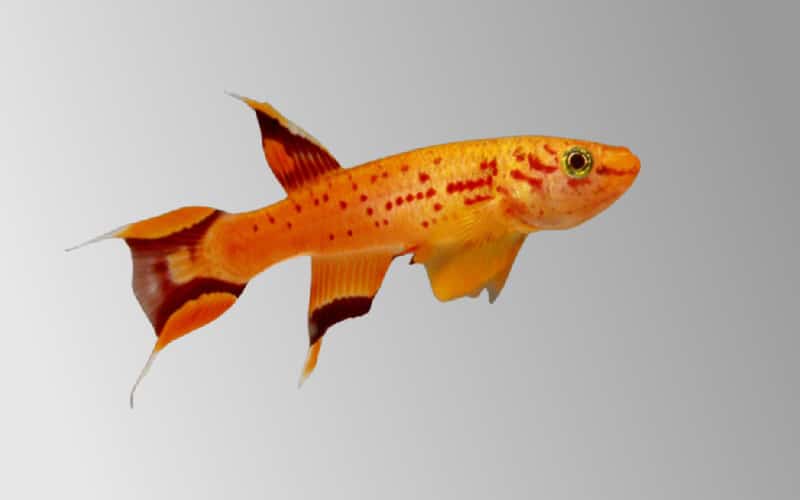
Lyretail Panchax are a gorgeous Killifish from Gabon in West Africa. These showy fish are very diverse in color and finnage; most males have solid stripes on their tail fins while others have flowing twin trailers that explain their common name.
As non-annual Killifish they are longer lived and more often captive-bred, which means they will usually accept prepared foods.
While males will display and chase they aren’t as aggressive towards each other compared to other species and can be kept together easily. Lyretail Panchax are small but quite bold and will frequent all areas of the aquarium, happily exploring and searching for prey.
- Scientific Name: Aphyosemion australe
- Breeding Habit: Non-Annual
- Adult Size: 2″
- Aquarium Size: 10+ Gallons
- Temperament: Peaceful
- Difficulty: Easy
Blue Gularis

The Blue Gularis is one of the largest Killifish species and is native to Nigeria and Cameroon in West Africa.
They are especially impressive; males can to 5 inches and have a triple forked tail and flowing dorsal and pectoral fins to match their brightly spangled bodies.
Blue Gularis can be a challenge for community tanks. They vary from neutral in temper to somewhat aggressive. They are opportunistic predators and can easily swallow a small Guppy or Tetra when fully grown. Blue Gularis may nip at tankmates they can’t eat on occasion as well.
Like many Killifish species, the Blue Gularis comes in several other color morphs based both on captive breeding efforts as well as naturally occuring regional variants like Gularis “Dwarf Red” and “Niger Delta.”
- Scientific Name: Fundulopanchax sjoestedti
- Breeding Habit: Non-Annual
- Adult Size: 5″
- Aquarium Size: 30+ Gallons
- Temperament: Semi-aggressive
- Difficulty: Easy
American Flagfish
American Flagfish are found exclusively in Florida, preferring weed-choked waterways full of places to hide. They get their name from the bright red, silver, and blue spangles of adult males, with a bit of green mixed in as well.
Unlike nearly every Killifish, American Flagfish are mostly vegetarian, grazing on algae, detritus, and soft leaved plants like Elodea. If your tank has none of these, provide blanched zucchini and spirulina flakes regularly. They should also be given protein-rich flakes and frozen foods on occasion.
The size difference between male and female American Flagfish is dramatic; males are easily twice as bulky as their partners. They are fairly easy to breed and in nature, males will guard the eggs until hatching.
- Scientific Name: Jordanella floridae
- Breeding Habit: Non-Annual
- Adult Size: 3″
- Aquarium Size: 20 Gallons
- Temperament: Peaceful
- Difficulty: Easy
Clown Killifish

Also known as Banded Panchax, Clown Killifish are strikingly patterned West African Killies that are tiny and do well in groups of 6 or more. These Killifish are slightly sensitive to poor water quality and require established tanks with ample filtration.
Heavily planted aquascapes are preferred and the shade created by plants combined with a dark substrate will bring out better color.
Like most Killies Clown Killifish prefer neutral to slightly acidic water and warm temperatures, from 75-80F. As tiny predators they have a strong preference for moving food and while they can be trained to accept dead, frozen items they prefer live prey like daphnia, brine shrimp, and fruit flies.
- Scientific Name: Epiplatys annulatus
- Breeding Habit: Non-Annual
- Adult Size: 1.5″
- Aquarium Size: 5+ Gallons
- Temperament: Peaceful
- Difficulty: Moderate
Killifish Care
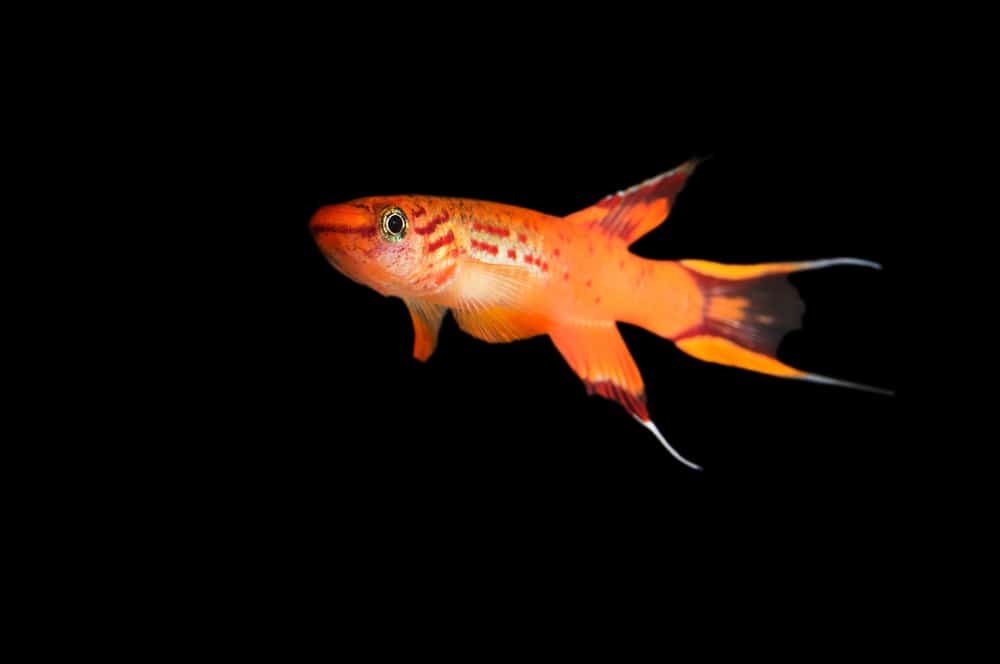
Killifish range from easy to moderately difficult to care for. Most are actually very hardy and undemanding in terms of water conditions like temperature and pH.
Killifish are also inexpensive and usually peaceful aquarium inhabitants with incredible color.
However, many come from such specialized habitats that you need to be aware of their quirks. Some won’t accept prepared foods like flake or pellets. Others are intolerant of other males. Some are quite aggressive towards all fish. And a few can’t handle poor water quality (ammonia, nitrites).
Breeding killifish, particularly annual species, is also a challenge that requires quite a bit of preparation. Overall, you just need to do your research before buying Killifish.
Aquarium Size
Killifish are some of the best fish for nano aquariums because many of them come from temporary ponds and streams. Some are found in bodies of water less than an inch deep.
Nano aquascapes with a single male and female, live plants, and shrimp are a simple yet attractive habitat that may even result in baby Killifish to raise.
Nearly all male Killifish are territorial to a degree. Schooling species like Lampeyes and Clown Killifish break this rule. For other Killifish, you should provide 10 gallons of space per male.
Plants, driftwood, rocks, and other breaks in line of sight help the losers of an occasional scuffle escape.
Never forget that all Killifish are jumpers. They are mostly surface dwellers and will leap in nature to take out insects crawling on nearby branches or to escape predators.
A hood with few holes is essential to keep them from ending up on the floor.
Water Conditions
With few exceptions Killifish prefer neutral to slightly acidic water (pH 6.0-7.0) with a temperature ranging from 75 to 80F. Given their specialized nature, some Killifish sit outside this range, such as the Blackfin Pearlfish, a coldwater Killifish.
Aquarium salt is beneficial to most Killifish; the high evaporation rates of their home waters often result in slightly saline conditions.
Aquarium salt also boosts immunity, stimulates slime coat production, and inhibits many infectious agents. The American Flagfish can handle salt up to full brackish water.
Most can tolerate slightly elevated ammonia or nitrites but should not be subjected to them for extended periods of time.
Many of the more exotic Killifish are not tolerant of poor water quality and will die if water parameters are not carefully monitored.
Killifish Tank Mates
As a general rule, Killifish get along perfectly with any fish that won’t eat them. As small as they are, many species will be shy when kept with larger fish. But in a mixed community tank Killifish do well, save exceptions like the Blue Gularis.
Good Killifish Tank Matses Include:
- Tetras
- Rasboras
- Gourami
- Livebearers
- Small Barbs
- Dwarf Cichlids
Feeding Your Killifish
Feeding Killifish can be one of the most difficult aspects of keeping them. Many species won’t accept prepared foods like flakes and pellets.
Captive bred non-annual Killifish are the most likely to accept prepared foods but even they should be given nutritious live and frozen foods regularly.
Brine shrimp, bloodworms, fairy shrimp, blackworms, daphnia, mosquito larvae and tubifex worms are all commonly used fresh and frozen to feed Killies.
Annual Killifish have high metabolisms due to their rapid growth rate and require live prey from the moment they hatch. They can be trained onto frozen food by mixing live and thawed items, adding less and less live food over time.
All Killifish are carnivorous (except the American Flagfish) and eat frequently; three light feedings a day is better than a single large meal.
Larger Killifish like the Golden Wonder and Blue Gularis appreciate live insects, small earthworms, feeder guppies, and other treats on occasion.
Breeding Your Killifish
Inducing your Killifish to breed is a matter of providing the right materials at the right time. Annual Killifish are wired to breed as swiftly as possible and aren’t picky about water conditions.
They do require a proper substrate, however. Non-annual Killifish are less complicated but breed and mature more slowly as a result.
Soil Versus Plant Spawners
Killifish have two reproductive methods that you’ll need to know before breeding them.
Annual Killifish are soil spawners in nature; once mature they dive into the mud to place their eggs. They need aquariums with a soil or peat substrate in order to breed. Aquarists with gravel or sand bottoms can include a cup of peat as a designated spawning platform.
Plant spawning Killifish are non-annual and deposit their eggs in plants like most other fish do.
One option is providing tangled, filamentous plants like Java Moss and Guppy Grass(Najas Guadalupensis). Plant spawning Killifish will preferentially lay their eggs on these plants and the fry will use them for cover as they grow.
Alternatively, you can provide artificial Spawning Mops for your Killifish. While not as attractive, the benefit of a Spawning Mop is that you can easily remove any attached eggs and place the mop anywhere in the tank. Usually, the Mop is placed near the surface to keep other fish from eating eggs or fry.
Once you have the eggs, you can raise plant spawning Killifish fry as you would any other aquarium fish young.
If your tank is densely planted and mature enough for a diverse microorganism culture a few fry should survive to adulthood on their own.
Annual Killifish Dry Season
Annual Killifish eggs require you to simulate the natural dry seasons they endure in nature or they won’t fully develop. This fascinating breeding strategy is rare in the fish world.
While the eggs never fully dry out they are resilient thanks to their protective outer coating (the chorion) and can even pass through the digestive tracts of birds unharmed, almost like fish seeds.
When you buy annual Killifish by mail, you’ll usually get a packet of eggs in peat, so these instructions will help you raise your new Killifish.
Once your adults have spawned, you’ll need to remove the spawning substrate with attached eggs and allow it to dry until it reaches a moist yet not fully dessicated condition.
Killifish eggs should be allowed to stay damp for 2-3 months, depending on the species. While breeders sell special incubators, a box kept in an area that won’t drop below 50F is more than enough.
Simply check the humidity of your substrate from time to time, misting it with water as it dries to keep it moist.
You can take a magnifying glass to check on the eggs as they develop. You want to look out for the silver and black eyes of the developing Killifish fry.
Once you see eyes looking back, spread the egg-laden peat into a pool of 68-75F water with a pH that’s neutral to slightly soft. You only need 1-2 inches of depth; any more and the fry will have difficulty finding food. Also include a bubbler for extra aeration (young Killifish need the gases immediately to inflate their swim bladders).
The first round of fry should begin hatching within hours to a day, depending on the species. One adaptation Killifish have to avoid “false springs” is cycles of maturation and hatching.
Not all of the eggs will be fully mature and not all of the eggs will hatch the first time water is offered. This way, if the rains haven’t fully arrived and the pool dries up again, more Killifish will hatch when the pool refills.
Raising Killifish Fry
As tiny as they are, Killifish fry require equally tiny live prey items. No matter how fine you grind it, crushed flake will be ignored. Live baby brine shrimp are easy to raise and elicit a strong feeding response.
Infusoria (plankton) and vinegar worms can be easily cultured during the dry season. Microworms are another option and can be purchased at aquarium stores.
Fortunately, Killifish mature quickly, especially annuals. Males grow faster than females and both are sexually mature in as little as 3 weeks in some African species.
The rains can come and go so quickly Killifish need to be ready to breed before the pools dry out.
Frequently Asked Questions about Killifish
Killifish are mostly omnivorous. This means that they feed on both plant and animal matter. Besides algae and soft plants they hunt for tiny animals they find in nature. Worms, baby brine shrimp, daphnia, mosquito larvae, and baby fish are the sort of animals they normally eat. Therefore any pellet or flake food rich in whole plant and animal ingredients is also perfect for them!
Hatching killifish eggs depends on the kind of killifish you have. Soil spawning annual killifish have to undergo a dry period where the eggs are moist but removed from the water for a few weeks. I detail how to raise annual killifish in a section of this guide above. Plant spawning killifish eggs can remain submerged and hatch just like any other fish eggs!
Like most species the Marsh Killifish is omnivorous. They normally feed on algae, soft aquatic plants, baby grass shrimp, fish eggs, mosquito larvae, and anything else small enough to eat.
Killifish are mostly peaceful towards other fish, especially fish that look nothing like them in color or shape. But they can be fairly aggressive towards each other, especially males when it is time to breed. A few of the larger types of killifish can also be temperamental towards their tank mates, especially the Blue Gularis (Fundulopanchax sjoestedti).
Most killifish are somewhat social. They aren’t schooling fish but they do enjoy the company of their own kind and interact in interesting ways. The males may fight but they rarely do lasting harm to one another. It is recommended that you keep 3 to 5 killifish together in any aquarium!

